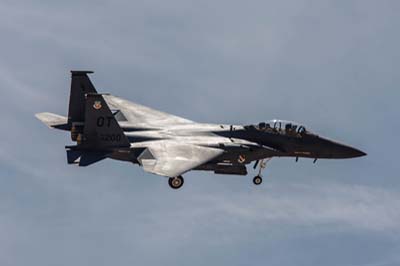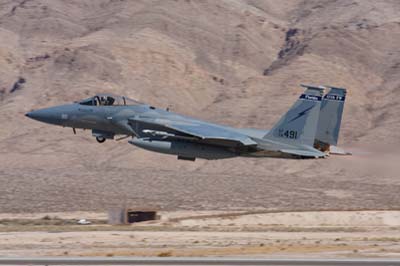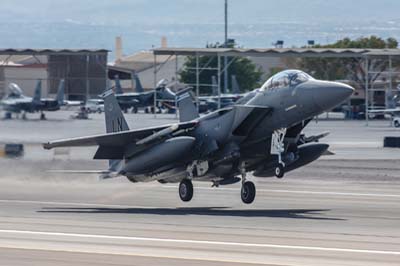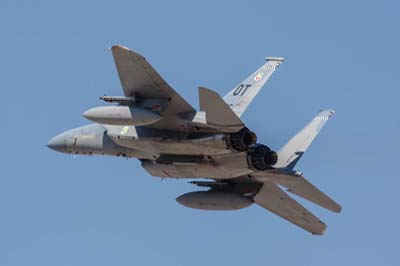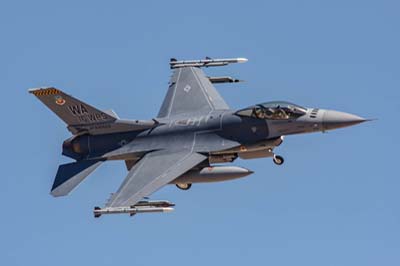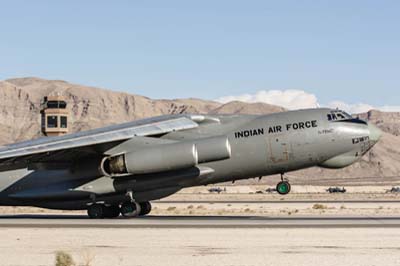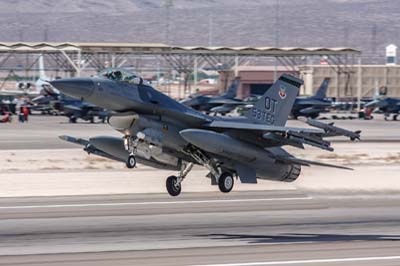Exercise 'Red Flag 08-4'
Nellis AFB
Nevada, August 11-28, 2008
|
Philip Stevens reports: Exercise 'Red Flag 08-4' - Russian Fighters over Nevada.
Nellis Air Force Base (AFB) in Nevada is the home of the US Air Force Warfare Centre (USAFWC), tasked with training pilots to become the best combat aviators in the world. The USAFWC has at its disposal every aircraft in the air force's inventory with the huge Nellis Air Force Range (NAFR) just to the north of the airfield. Divided now into two zones, north and south, the NAFR is the largest US range covering some 4,700 square miles. A larger area of 14,800 square miles, which is half the size of Scotland, is available for military flying operations. The NAFR contains dummy airfields, unprepared runways, Surface to Air Missile (SAM) sites, Surface to Surface Missiles (SSM), Anti-aircraft artillery and bunkers, in fact everything you would expect in a war zone. The training is conducted with air and ground units of the Army, Navy and Marine Corps. Many allied nations are also able to train at Nellis, it is vital that the Allied coalition forces as seen during both Gulf Wars, are able to fly and fight together as one seamless unit.
Four or more times a year, Red Flag exercises, involving around 1,200 aircraft flying over 20,000 sorties, are run by the 414th Combat Training Squadron (CTS), 57th Operations Group (OG) of the 57th Wing (WG). The ten day exercises are designed to enable US and Allied forces to fight together in the most realistic way possible. For Red Flag 08-4, the fourth exercise of the fiscal year, the French (FAF), Indian (IAF) and Republic of Korea (RoKAF) air forces were invited to fly with and against US forces based in the US, UK and Japan. The IAF with eight Sukhoi Su-30MKI's and the RoKAF, with six Boeing F-15K Slam Eagle's, were attending Red Flag for the
first time.
A White Force of 414 CTS staff construct combat scenarios where friendly Blue Air force is required to attack a defending Red Air force. The training programs are designed to reflect each unit's requirements, with the threat environments being discussed at length before and during the exercise. The White Force issue an Air Tasking Orders (ATO) to members of several squadrons who take turns as a mission commander, to prepare a plan for the package commanders to follow. Targets such as SSMs and SAMs are moved within the area of operations each day, White Force commanders will then issue intelligence updates to the Blue Air mission planners. The exercise scenarios usually
build up in their size and complexity as the exercise progresses.
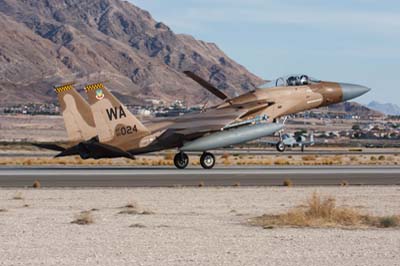 The Red Air force is part of a simulated Air Defence System flying in the Defensive Counter Air (DCA) role. They usually consist of packages of a dozen or more Nellis based Boeing (McDonnell Douglas) F-15C/D Eagles of the 65th Aggressor Squadron (AGRS) and Lockheed (General Dynamics) F-16C/D Fighting Falcons of the 64th AGRS. Both Aggressor squadrons belong to the 57th Adversary Tactics Group (ATG) which comes under 57 WG. These aircraft sport differentiating Russian style camouflage and codes, their experienced pilots employing mission tactics based on intelligence of potentially hostile air forces. Aggressor pilot intelligence briefings are reported to be held weekly in two hour sessions.
The Red Air force is part of a simulated Air Defence System flying in the Defensive Counter Air (DCA) role. They usually consist of packages of a dozen or more Nellis based Boeing (McDonnell Douglas) F-15C/D Eagles of the 65th Aggressor Squadron (AGRS) and Lockheed (General Dynamics) F-16C/D Fighting Falcons of the 64th AGRS. Both Aggressor squadrons belong to the 57th Adversary Tactics Group (ATG) which comes under 57 WG. These aircraft sport differentiating Russian style camouflage and codes, their experienced pilots employing mission tactics based on intelligence of potentially hostile air forces. Aggressor pilot intelligence briefings are reported to be held weekly in two hour sessions.
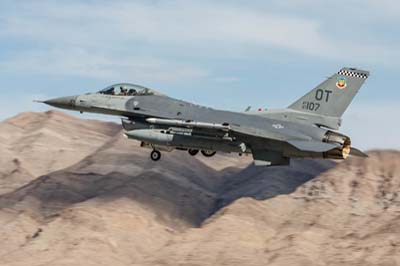 During Red Flag 57 WG are often supplemented by aircraft and pilots from the 422nd Test and Evaluation Squadron (TES), 53rd Test and Evaluation Group (TEG) under 53 WG another Nellis based squadron, as was the case during this Flag.
During Red Flag 57 WG are often supplemented by aircraft and pilots from the 422nd Test and Evaluation Squadron (TES), 53rd Test and Evaluation Group (TEG) under 53 WG another Nellis based squadron, as was the case during this Flag.
Whilst it may appear that they are only a small force, once 'shot' down, Red Air aircraft can regenerate themselves and so for a typical 90 minute mission they could represent a hostile force four times its actual size. A Red Air's air refuelling tanker flies a racetrack pattern behind their regeneration line. A 'downed' Red Air fighter once behind this line can get a full tank of fuel and be back in the fight a few minutes later.
Blue Air fly Offensive Counter Air (OCA) missions, their fighter aircraft are tasked to target Red Air and to escort air-to-ground strike packages. The integration of the Combined Air Operations (COMAO) packages is the key to success of the mission, flying with pilots from four or more nations is the challenge. Pilots during the exercise fly two daily missions, one day and one night.
All aircraft have Airborne Instrumentation Sub-system (AIS) pods for use on the Air Combat Manoeuvring Instrumentation (ACMI) ranges, to relay an aircraft's flight and weapon data to the Nellis Air Combat Training System (NACTS). This system incorporates the Red Flag Measurement and Debriefing Systems (RFMDS) which is used in real-time to monitor individual aircraft during missions and for post-mission analysis by reconstructing the manoeuvres and tactics used against the targets and simulated threats.
A Southern Area of Operations (AO) is used for ground targets, which include moving targets (e.g. convoys and tanks) and simulated urban conurbations. Close Air Support (CAS) operations are flown to protect the convoys and troops in an environment very similar to that of Iraq and Afghanistan. Joint Terminal Attack Controllers (JTAC) on the ground can call in aircraft to engage targets. Mostly inert weapons are used but some live munitions are dropped. Red Air fighters and SAM sites do not operate in the southern AO. |
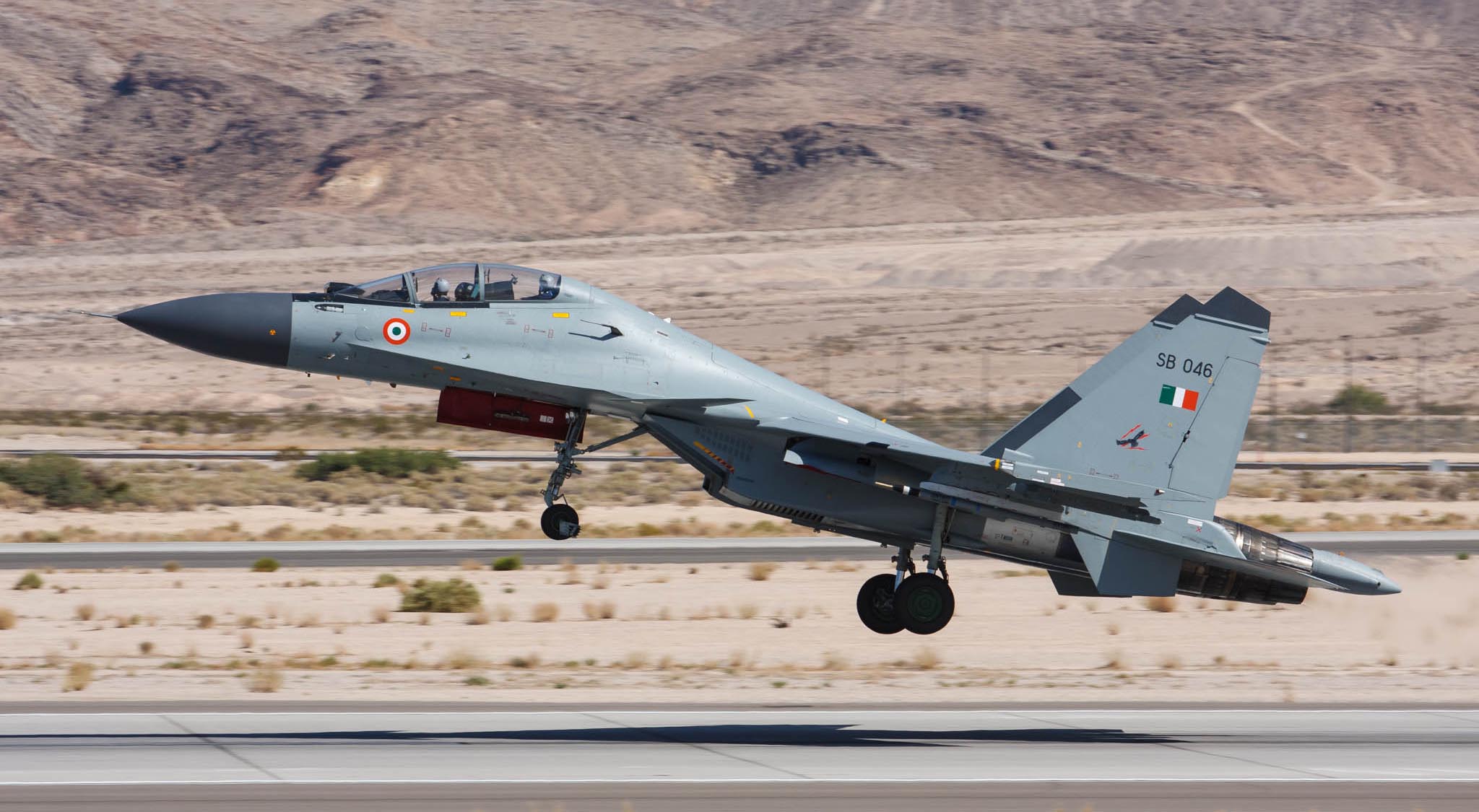 |
Sukhoi SU-30MKI 'Flanker-H' (SB046) flown by 20 Squadron ('Lightnings') departs Nellis on another Red Flag sortie.
|
Russian built fighters fight over Nevada
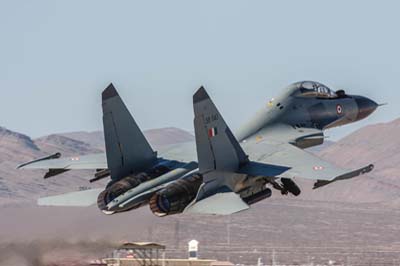 Formally as Red Flag observers, the IAF accepted a USAF invitation to attend Red Flag 08-4 with their latest and most advanced fighter, the Russian built Sukhoi Su-30MKI 'Flanker-H', flown by 20 Squadron ('Lightnings') from Air Force Station (AFS) Lohegaon near Pune. In support of the eight Su-30s were one Ilyushin IL-76MD 'Candid'
transport and two Ilyushin IL-78MKI 'Midas' air refuelling aircraft along almost 250 personnel, including 50 aircrew with an average age of late 20s.
Formally as Red Flag observers, the IAF accepted a USAF invitation to attend Red Flag 08-4 with their latest and most advanced fighter, the Russian built Sukhoi Su-30MKI 'Flanker-H', flown by 20 Squadron ('Lightnings') from Air Force Station (AFS) Lohegaon near Pune. In support of the eight Su-30s were one Ilyushin IL-76MD 'Candid'
transport and two Ilyushin IL-78MKI 'Midas' air refuelling aircraft along almost 250 personnel, including 50 aircrew with an average age of late 20s.
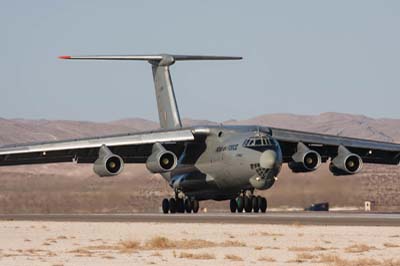 Whilst attending Red Flag for the first time, it is not the first time Indian and US military forces have trained together. Over the last seven years they have worked together around 50 times to improve 'functional interoperability', the previous joint military exercise, 'Malabar 2007', was staged last September in the Bay of Bengal.
Whilst attending Red Flag for the first time, it is not the first time Indian and US military forces have trained together. Over the last seven years they have worked together around 50 times to improve 'functional interoperability', the previous joint military exercise, 'Malabar 2007', was staged last September in the Bay of Bengal.
To gain a clear understanding of the working environment and to streamline procedures, the IAF for two weeks worked up with USAF F-15Cs from the 366th Fighter Wing (FW) and with F-16Cs from 18 AGRS at Mountain Home Air Base in Idaho, flying around 200 sorties. Some of the Su-30s were utilising the
Litening III advanced targeting pod fitted which has been integrated into the aircraft's software.
As during the bi-lateral exercise 'Indra Dhanush
2007, hosted at RAF Waddington last year, the Su-30 pilots were not authorised to use their new and classified Russian made Tikhomirov Scientific Research Institute of Instrument Design NIIP BARS radar. The Radar's operating frequencies are secret, they feared knowledge of which could enable jamming systems to be developed. The Indian Defence Ministry had stated; "While we have a good relationship with the US, we have to be careful about the future." With the imposed Su-30MKI's Radar restrictions Sukhoi pilots were vulnerable to air to air attack. As a consequence of the Radar ban their tasked air to air missions were reduced in favour of Suppression of Enemy Air Defence (SEAD) and air-to-ground missions. Also very active during the intense exercise were the IL-78MKI air refuelling tankers which flew alongside MacDill based KC-135R Stratotankers. The IL-76MD also played and active part during the exercise by fulfilling the tactical transport and large force engagement role throughout the exercise.
The two Su-30 squadrons ('Lightnings' and 'Rhinos') had moved out of AFS Lohegaon but recently they returned from AFS Jodhpur and will be joined by a third squadron in December 2009. The IAF's Su-30MKI's are produced by Hindustan Aeronautics at Nasik. |
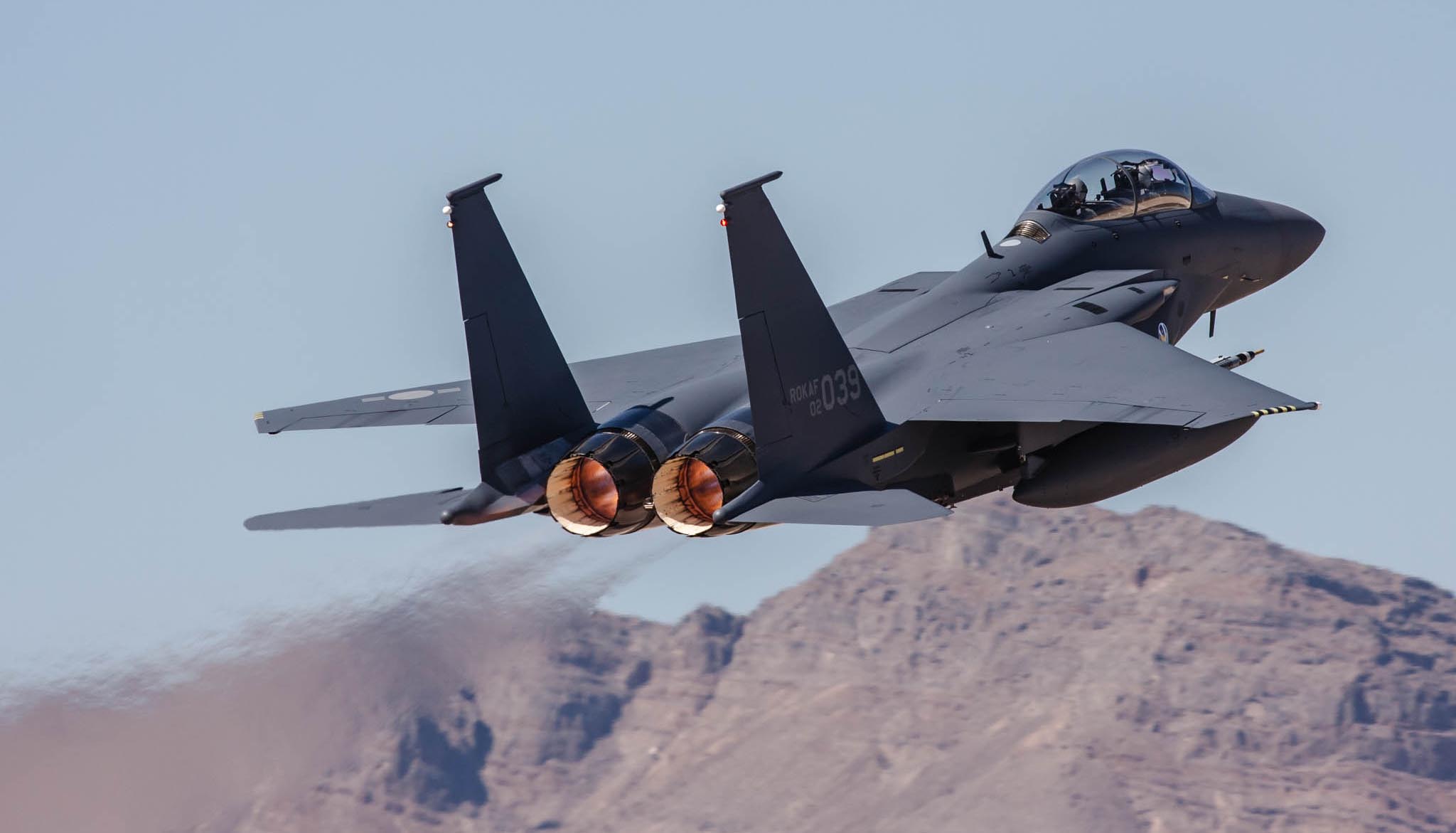 |
Boeing F-15K Slam Eagle (02-039) of the 102/122 Fighter Squadron, 1st Fighter Wing Republic of Korea Air Force departing Nellis
|
Republic of Korea Air Force (RoKAF) Red Flag debut
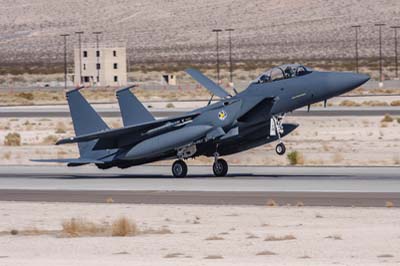 The RoKAF were also participating at Red Flag for the first time. Arriving with six F-15K Slam Eagles pooled from the 102nd and 122nd Fighter Squadrons of the 1st Fighter Wing based at Daegu in South Korea. The F-15K is a derivative of the F-15E Strike Eagle, selected by the RoKAF in 2002 deliveries of 40 aircraft commenced in 2005. The six F-15K (02-035 to 02-040) at Red Flag were the final aircraft in the batch and arrived at Nellis straight off the production line at Boeing's St.Louis factory. At the conclusion of Red Flag the new jets were ferried to South Korea. An additional order for 21 aircraft (one aircraft crashed in 2006) was placed in 2008, with deliveries expected to start in 2010.
The RoKAF were also participating at Red Flag for the first time. Arriving with six F-15K Slam Eagles pooled from the 102nd and 122nd Fighter Squadrons of the 1st Fighter Wing based at Daegu in South Korea. The F-15K is a derivative of the F-15E Strike Eagle, selected by the RoKAF in 2002 deliveries of 40 aircraft commenced in 2005. The six F-15K (02-035 to 02-040) at Red Flag were the final aircraft in the batch and arrived at Nellis straight off the production line at Boeing's St.Louis factory. At the conclusion of Red Flag the new jets were ferried to South Korea. An additional order for 21 aircraft (one aircraft crashed in 2006) was placed in 2008, with deliveries expected to start in 2010.
The F-15K has some advanced features not found on F-15E, such as an AAS-42 Infrared Search and Track (IRIS-T), Joint Helmet-Mounted Cueing System (JHMCS) and the advanced AN/APG-63 radar. As a work-up for the very challenging Red Flag missions aircrew in June completed the bi-lateral exercise 'Max Thunder 08-01' at Kunsan Air Base in South Korea.
Rafale debut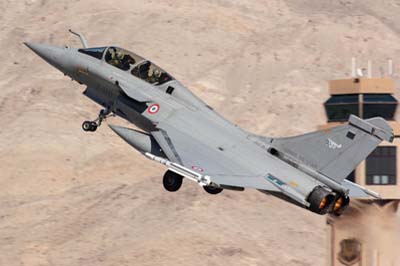
Making up a trio of non-US forces the French Air Force (Armée de l'Air) arrived at Red Flag with four two-seat Dassault Rafale Bs from Escadrille de Chasse EC.01/007 'Provence' which are based Saint Dizier-Robinson (BA 113). The Armée de l'Air have participated in Red Flags since 1981, however this was the first time for the Rafale and comes two years after they were put into service at St. Dizier. They were accompanied along their route via the Azores by a C-135FR tanker. The detachment consisted of 85 personnel which included 14 pilots and six navigators.
Prior to the exercise they deployed to Luke AFB, Arizona on July 28 to work-up with the F-16Cs of 309th Fighter Squadron (FS), 56th Fighter Wing (FW) reportedly scoring a 3:1 kill ratio on the first day, opposing pilots were apparently impressed with the Rafale's power and agility. During Red Flag the Rafale successfully evaded Red Air missiles and no hits were reported. The Rafale when tasked to take out targets on the ground utilised Sagem Defence Securite's AASM/GPS modular smart munitions, which can engage six targets simultaneously and this data can be exchanged using the Link-16 protocol. The Sagem Local Mission Planning Reply System (SLPRM) was used to support missions during the exercise. Four sorties per day of around two hours duration were flown two of which were as 'mission commanders'. |
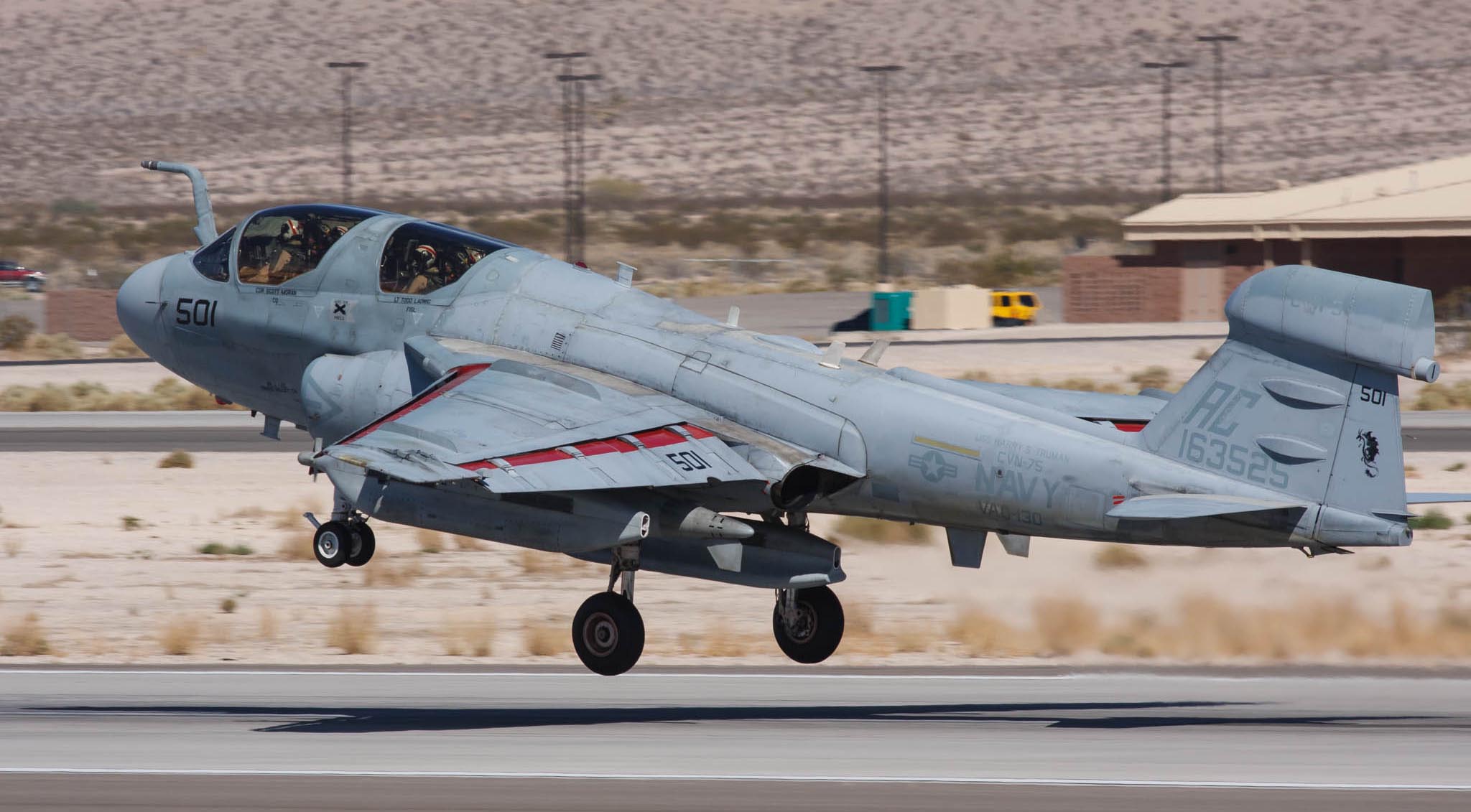 |
Suppression of Enemy Air Defences (SEAD) missions were carried out by EA-6B Prowlers with the F-16CJ Fighting Falcons. Their mission was to remove enemy electronic threats using AGM-88 HARM missiles, creating a 'safe' environment for the ground attack aircraft.
Tanker Task Force (TTF)
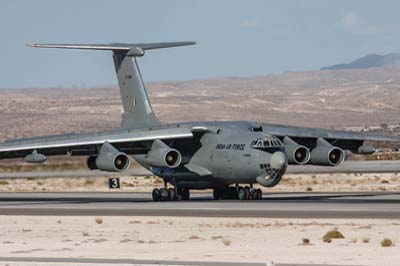 Up to 50 aircraft during each Red Flag mission may require additional fuel to complete their sortie, air to air refuelling is therefore a vital element of the exercise.
Up to 50 aircraft during each Red Flag mission may require additional fuel to complete their sortie, air to air refuelling is therefore a vital element of the exercise.
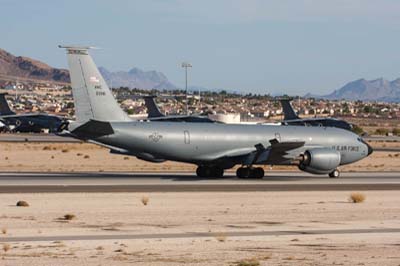 Three KC-135R Stratotankers of the 91st Air Refuelling Squadron (ARS), 6th Air Mobility Wing (AMW), based at MacDill AFB in Florida were deployed to Nellis. Usually one tanker is allocated to Red Air with two more available for Blue Air. The IAF provided there own air refuelling aircraft by way of two Ilyushin IL-78MKI 'Midas' tanker aircraft. The IL-78 is a development of the IL-76 'Candid' transport.
Three KC-135R Stratotankers of the 91st Air Refuelling Squadron (ARS), 6th Air Mobility Wing (AMW), based at MacDill AFB in Florida were deployed to Nellis. Usually one tanker is allocated to Red Air with two more available for Blue Air. The IAF provided there own air refuelling aircraft by way of two Ilyushin IL-78MKI 'Midas' tanker aircraft. The IL-78 is a development of the IL-76 'Candid' transport.
30 Year Old Objectives
The first Red Flag took place at Nellis in 1975. It was realised during the Vietnam War that pilots who survived ten combat missions were significantly more likely to survive subsequent missions. The aim of the Red Flag exercise was to create a safe training environment to simulate combat missions, producing 'combat' experienced pilots before they go to war. In the first thirty years of Red Flag 132,000 aircrew have flown 350,000 sorties. The objectives of Red Flag are as relevant today as they were over thirty years ago. |
The Air Assets Participating at Red Flag 08-4
Red Air - Defensive Counter Air (DCA)
F-16C/D Fighting Falcon, from the 64th Aggressor Squadron (AGRS), 57th Adversary Tactics Group (ATG), 57th Wing based at Nellis AFB (coded 'WA' black/yellow fin tip).
F-15C/D Eagle of the 65th Aggressor Squadron (AGRS), 57th Adversary Tactics Group (ATG), 57th Wing based at Nellis AFB (coded 'WA' black/yellow fin tip).
F-15C Eagle from the 85th Test and Evaluation Squadron (TES), 53rd Test and Evaluation Group (TEG), 53rd Wing jointly based at Eglin and Nellis AFB ('Skulls' coded 'OT' black/white fin tip).
Blue Air - Offensive Counter Air (OCA)
F-15C/D Eagle from the 159th Fighter Squadron, 125th Fighter Wing of the Florida Air National Guard (ANG) based at Jacksonville ANG Base at Jacksonville International Airport. (known as the 'Jaguars' with fin tip markings of blue/white with 'Florida' on the outside with '125th FW' on the inside).
F-15C/D Eagle from the 58th Fighter Squadron, 33rd Fighter Wing based at Eglin AFB, Florida (coded 'EG' with blue fin tip inscribed 'Gorillas').
2 x Rafale B from Escadrille de Chasse (EC) 01.007 'Provence' of the French Air Force based at Saint Dizier-Robinson (BA 113).
Air-To-Ground
F-15E Strike Eagle from the 17th Weapons Squadron, 57th Operations Group (OG), 57th Wing based at Nellis AFB (coded 'WA' with black/yellow fin tip).
F-15E Strike Eagle from the 492nd Fighter Squadron, 48th Fighter Wing based at RAF Lakenheath (coded 'LN' with blue fin tip).
F-15E Strike Eagle from the 493rd Fighter Squadron, 48th Fighter Wing based at RAF Lakenheath (coded 'LN' with red fin tip).
8 x Su-30MKI 'Flanker-H' from the 20th Squadron 'Lightnings' of the Indian Air Force based at AFS Lohegao near Pune.
6 x F-15K Slam Eagle from the 'pooled' 102ndh and 122nd Fighter Squadrons, 1st Fighter Wing of Republic of Korea Air Force based at Daegu AB, South Korea.
2 x Rafale B from Escadrille de Chasse (EC) 01/007 'Provence' of the French Air Force based at Saint Dizier-Robinson (BA 113).
Suppression of Enemy Air Defences (SEAD)
3 x EA-6B Prowler VAQ-130 'Zappers' and VAQ-142 'Gray Wolves' from NAS Whidbey Island, Washington.
F-16CJ/DJ Fighting Falcon from the 13th Fighter Squadron, 35th Fighter Wing from JASDF Misawa Air Base, Japan ('Panthers' coded 'WW' with red fin tip).
F-16CJ/DJ Fighting Falcon from the 14th Fighter Squadron, 35th Fighter Wing, from JASDF Misawa Air Base, Japan ('Samurais' coded 'WW' with yellow fin tip).
F-16CJ Fighting Falcon 422nd Test and Evaluation Squadron (TES), 53rd Test and Evaluation Group (TEG), 53rd Wing from Nellis AFB ('Green Bats' coded 'OT' with black/green fin tip).
Command and Control; Intelligence, Surveillance
2 x E-3B AWACS of 964th Airborne Air Control Squadron (AACS), 552nd Air Control Wing (ACW) based at Tinker AFB, Oklahoma (tailcode 'OK' and red fin tip).
Airlift
1 x IL-76MD 'Candid' of the 44th (Transport) Squadron Indian Air Force based at AFS Nagpur.
C-17 Globemaster III of 62nd Airlift Wing from McChord AFB, Washington.
Air Refuelling
3 x KC-135R Stratotankers of the 91st Air Refuelling Squadron (ARS), 6th Air Mobility Wing (AMW) based at MacDill AFB.
2 x IL-78MKI 'Midas' of the 78th (Tanker) Squadron, Indian Air Force based at AFS Agra. |
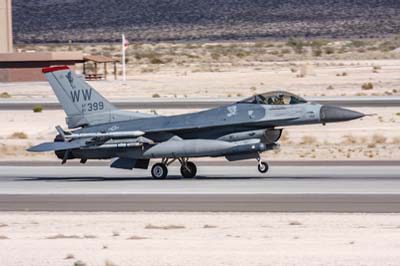 |
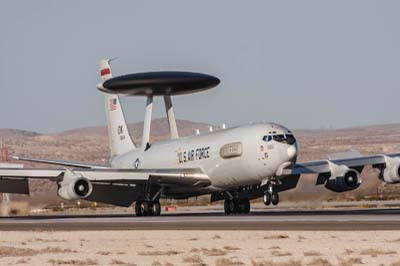 |
Photography at Nellis AFB
It was hot, very hot over 50 degrees Celsius between the parallel runways, additional photography was taken at North Las Vegas Boulevard by the speedway track and also at the other end of the runways on East Cheyenne Avenue.
Left to right:
Departing F-15C Eagle (85-0126 OT) 85 TES, 53 WG from E Cheyenne Av with a Canon EOS 40D and 300mm lens.
Returning F-16CJ Fighting Falcon (93-0553 WA '16 WPS') of 16 WPS, 57 WG from North Las Vegas Boulevard by the speedway track with a Canon EOS 40D and 300mm lens + x1.4 extender.
Returning Ilyushin IL-76MD 'Candid' (K-2661) of 44 (Transport) Squadron Indian AF from beside the runway with a Canon EOS 40D and 70-200mm (70mm) f2.8 lens.
Departing F-16CG Fighting Falcon (87-0362 '53 TEG' OT) of 422 TES, 53 WG from the tower between the parallel runways with a Canon EOS 40D and 300mm lens. |
| Special thanks to all the members of Nellis AFB Public Affairs team who without their efforts this report would not have been possible. My thoughts were constantly of Lt Col Thomas Bouley, commander of the 65th Aggressor Squadron who was killed when his F-15D Eagle crashed near Goldfield in the Nevada desert during the first week of the exercise. I had been in contact with him and was hoping to meet up. It just brings it home how real this all is and that it is not just an exercise in aviation photography. My heart goes out to his family. |

 Formally as Red Flag observers, the IAF accepted a USAF invitation to attend Red Flag 08-4 with their latest and most advanced fighter, the Russian built Sukhoi Su-30MKI 'Flanker-H', flown by 20 Squadron ('Lightnings') from Air Force Station (AFS) Lohegaon near Pune. In support of the eight Su-30s were one Ilyushin IL-76MD 'Candid'
transport and two Ilyushin IL-78MKI 'Midas' air refuelling aircraft along almost 250 personnel, including 50 aircrew with an average age of late 20s.
Formally as Red Flag observers, the IAF accepted a USAF invitation to attend Red Flag 08-4 with their latest and most advanced fighter, the Russian built Sukhoi Su-30MKI 'Flanker-H', flown by 20 Squadron ('Lightnings') from Air Force Station (AFS) Lohegaon near Pune. In support of the eight Su-30s were one Ilyushin IL-76MD 'Candid'
transport and two Ilyushin IL-78MKI 'Midas' air refuelling aircraft along almost 250 personnel, including 50 aircrew with an average age of late 20s. Whilst attending Red Flag for the first time, it is not the first time Indian and US military forces have trained together. Over the last seven years they have worked together around 50 times to improve 'functional interoperability', the previous joint military exercise, 'Malabar 2007', was staged last September in the Bay of Bengal.
Whilst attending Red Flag for the first time, it is not the first time Indian and US military forces have trained together. Over the last seven years they have worked together around 50 times to improve 'functional interoperability', the previous joint military exercise, 'Malabar 2007', was staged last September in the Bay of Bengal.

